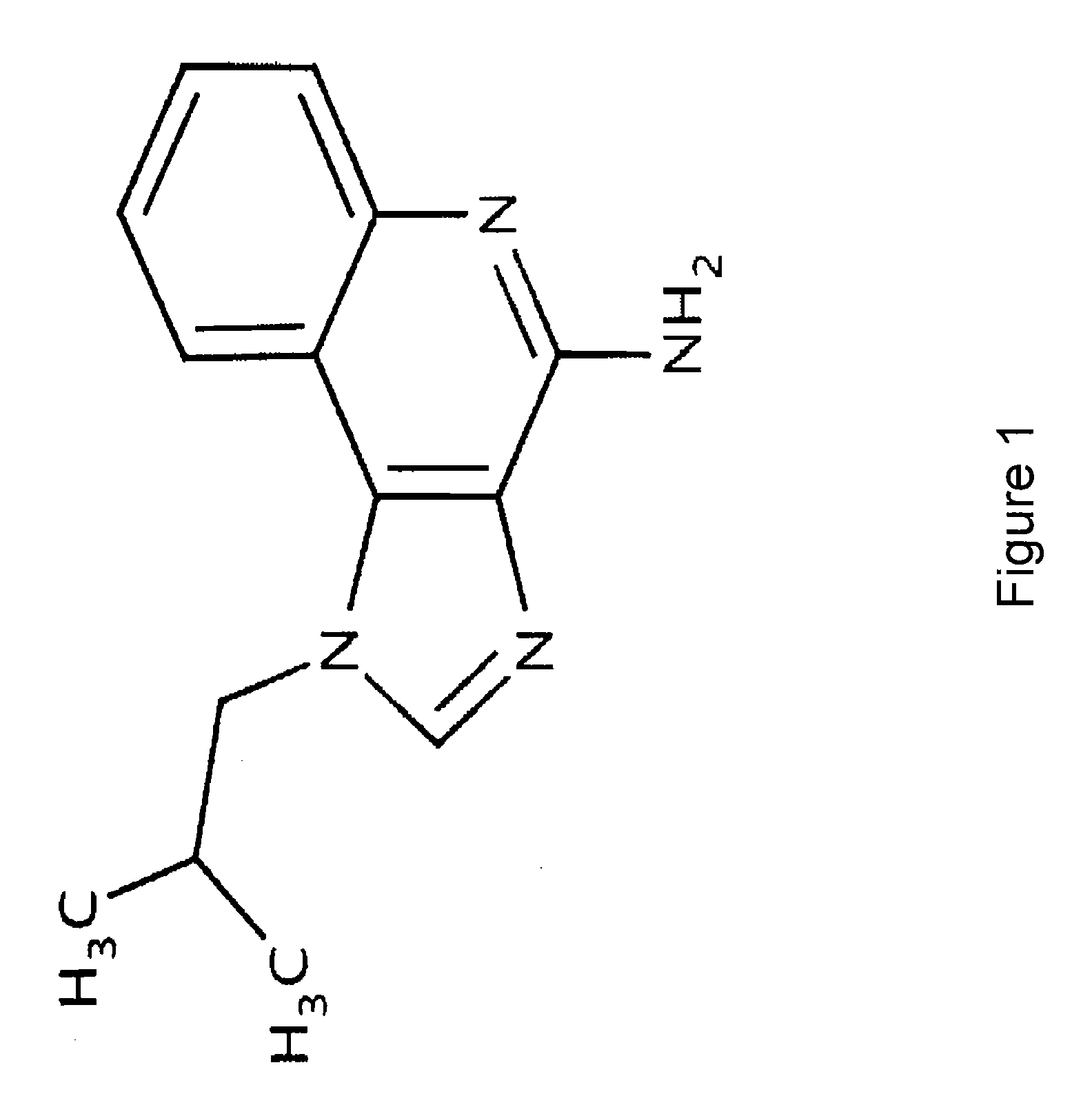Pharmaceutical Formulations for Iontophoretic Delivery of an Immunomodulator
a technology of immunomodulator and pharmaceutical formulation, which is applied in the direction of biocide, drug composition, therapy, etc., can solve the problems of inconvenient use, limited efficacy, and administration of topical creams, and achieve the effect of increasing the residence tim
- Summary
- Abstract
- Description
- Claims
- Application Information
AI Technical Summary
Benefits of technology
Problems solved by technology
Method used
Image
Examples
example 1
Solubility Study of Solvent Combinations
[0058]Without wishing to be bound by any particular theory, it is believed that the development of a suitable formulation for delivery of imiquimod into the skin by iontophoresis would require the drug to permeate through the stratum corneum and into the underlying epidermis / dermis, where it should remain for a prolonged period (hours to days).
[0059]Achieving a long residence time may be possible using a saturated fatty acid, diethylene glycol monoethyl ether (Transcutol P; Gattefosse Co.), propylene glycol, PEG 400, or combinations thereof. A solubility study of combinations of solvents to achieve maximum solubility of imiquimod in solution was designed and is depicted in Table 1.
TABLE 1Composition and Solubility of Imiquimod Formulations (w / w)SamplePropyleneIsopropylpH adjustmentSolubility#glycolPEG 400Transcutol PTween 80myristateGlycerinto ~3.6(mg / ml)1—20—3—101N HCl acid0.41721020—3—101N HCl acid0.34831020203—101N HCl acid0.85741020—3—101N...
example 2
Epidermal, Dermal, and Transdermal Delivery of a 0.3% w / w Imiquimod Formulation in Hairless Rat Skin In Vitro
[0061]Transdermal drug delivery offers an appealing alternative to invasive hypodermic needles and the safety and bioavailability disadvantages often associated with oral drug delivery. However, the stratum corneum, the outermost layer of skin, is a formidable barrier to many compounds. As a result, effective permeation through skin is generally limited to small, lipophilic molecules. To enhance the permeation of macromolecules, as well as hydrophilic and hydrophobic small molecules, techniques such as iontophoresis are shown herein to enhance delivery.
[0062]The effect of iontophoresis on the permeation profile of imiquimod across hairless rat skin in vitro was examined. The solubility of imiquimod was tested in various solvent matrices and a formulation with acceptable solubility was employed for further in vitro and in vivo studies as described herein. The following methods...
example 3
Quantification of an Imiquimod Skin Depot in Hairless Rats In Vivo Using a 0.3% w / w Imiquimod Formulation
[0067]The effect of iontophoresis on its ability to enhance delivery of 0.3% w / w imiquimod (pH 4.0) formulation in vivo into the stratum corneum and the underlying skin (lower epidermis and dermis) was examined. The following methods were performed.
[0068]Hairless rats were anesthetized using Ketamine and Xylazine. An area on the abdomen was marked and cleaned. Drug formulation was loaded onto an iontophoretic drug cartridge and was secured on the area with tape. For iontophoretic delivery, the cartridge was connected to a current source and a TransQ iontophoretic patch (Iomed) served as the counter electrode. A current density of 0.2 mA / cm2 was applied for 15 min. At the end of 15 min, the drug loaded cartridges were removed and excess drug on the site was removed. Tape stripping (3M Transpore™ tape) was performed to quantify the drug levels in the stratum corneum. Transepidermal...
PUM
| Property | Measurement | Unit |
|---|---|---|
| Fraction | aaaaa | aaaaa |
| Percent by mass | aaaaa | aaaaa |
| Percent by mass | aaaaa | aaaaa |
Abstract
Description
Claims
Application Information
 Login to View More
Login to View More - R&D
- Intellectual Property
- Life Sciences
- Materials
- Tech Scout
- Unparalleled Data Quality
- Higher Quality Content
- 60% Fewer Hallucinations
Browse by: Latest US Patents, China's latest patents, Technical Efficacy Thesaurus, Application Domain, Technology Topic, Popular Technical Reports.
© 2025 PatSnap. All rights reserved.Legal|Privacy policy|Modern Slavery Act Transparency Statement|Sitemap|About US| Contact US: help@patsnap.com



